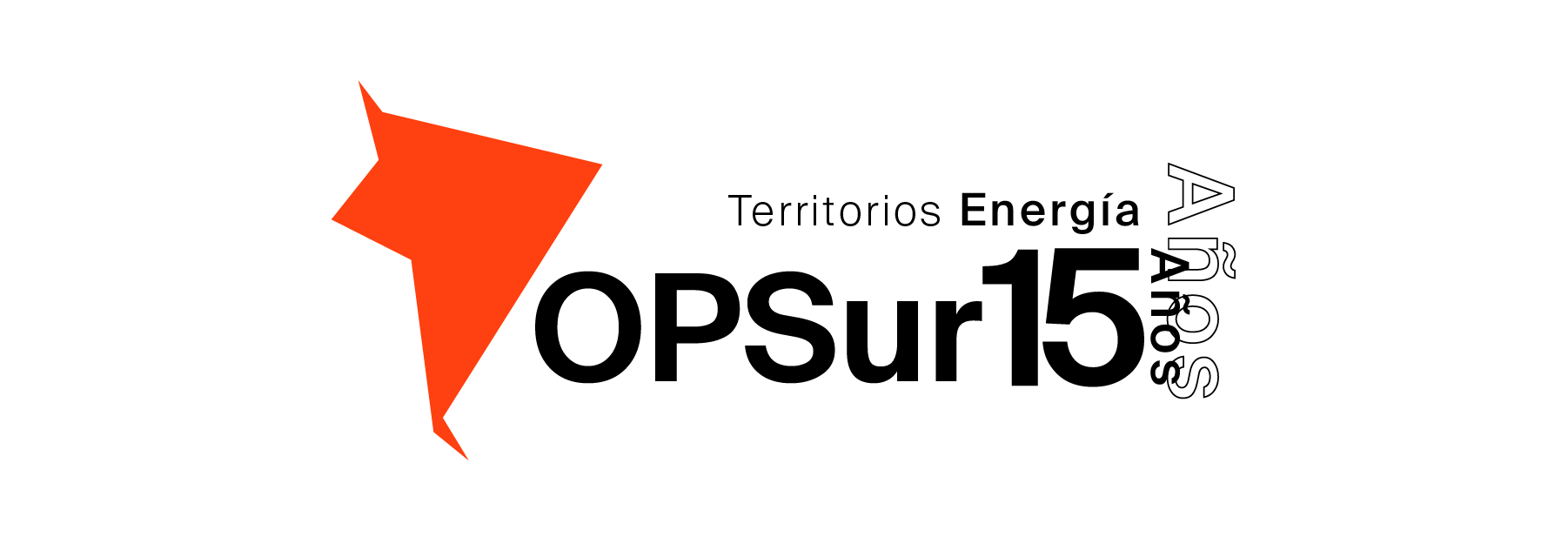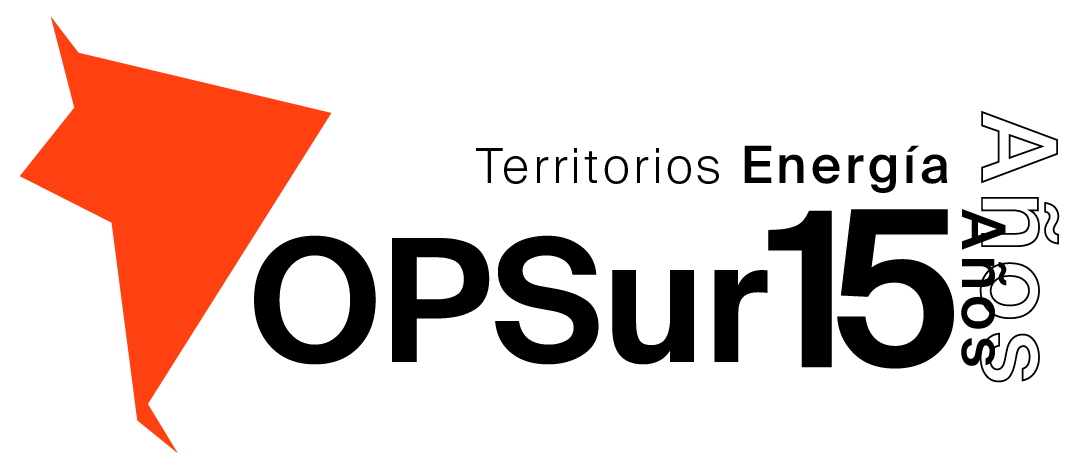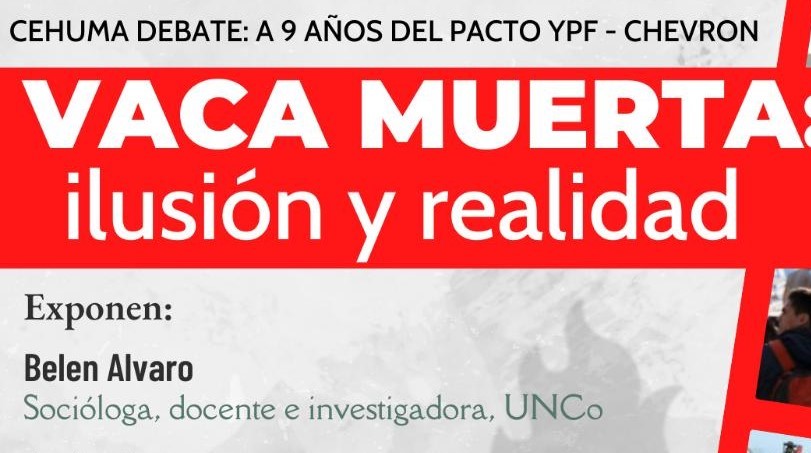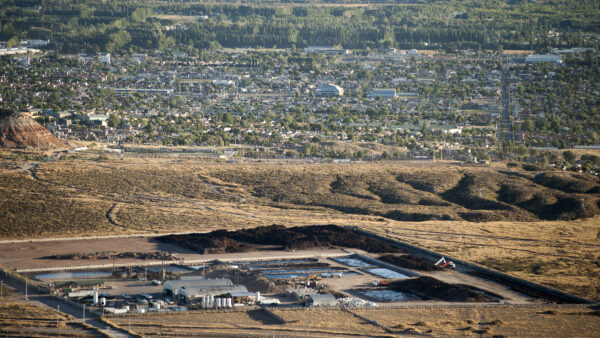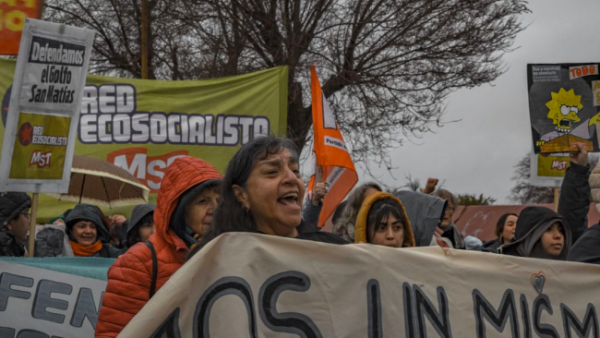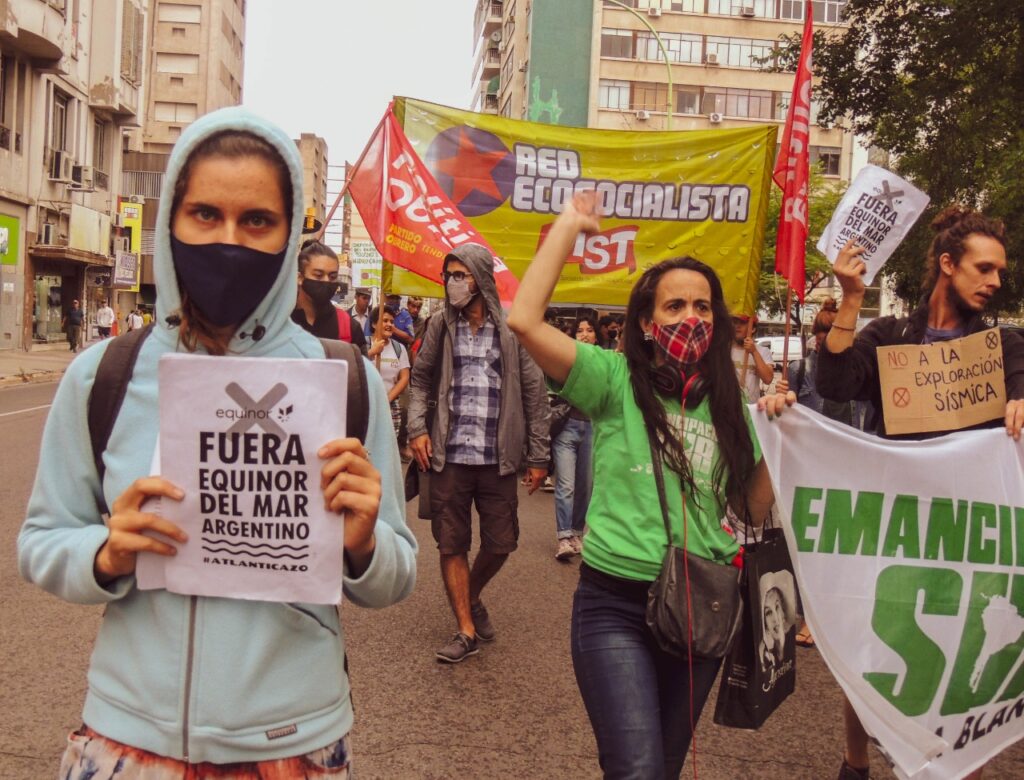
Fotos: Asamblea por un mar libre de petroleras
By OPSur / Translated by Territorio de Ideas.- In December 2021, Al Cook, Executive Vice President at Equinor, stated that the company “aspires to be a leader in energy transition” and that the agreement entered into with oil company YPF underlines those goals in Argentina. “We strive to actively cut down carbon emissions in the countries where Equinor invests. Based on our joint projects and shared ambitions regarding climate change, we will continue to work with YPF to reduce emissions in our oil and gas operations in Vaca Muerta and in offshore Argentina,” Al Cook explained after meeting with Argentine President Alberto Fernández(1).
“We pride ourselves on having varied energy businesses in the country, ranging from oil to gas and solar energy. By growing our partnership with YPF, Equinor wishes to keep working together in realizing the country’s energy potential. We intend to create value and bring about a positive social impact,” said Nidia Alvarez, President of Equinor Argentina, during the meeting with the Argentine head of state.
However, since Equinor arrived in Argentina in 2017, their business portfolio has mostly focused on fossil projects and not quite on promoting the development of renewable energy sources. The company behaves like an oil company, rather than like an energy company. Its arrival in the country took place in a context of slow expansion towards Latin America (Brazil, Surinam, Mexico), which started at the beginning of the millennium, and is geared towards pushing the extractive frontiers and promoting extreme energies: ultra-deepwater hydrocarbons and fracking in tight formations(2).
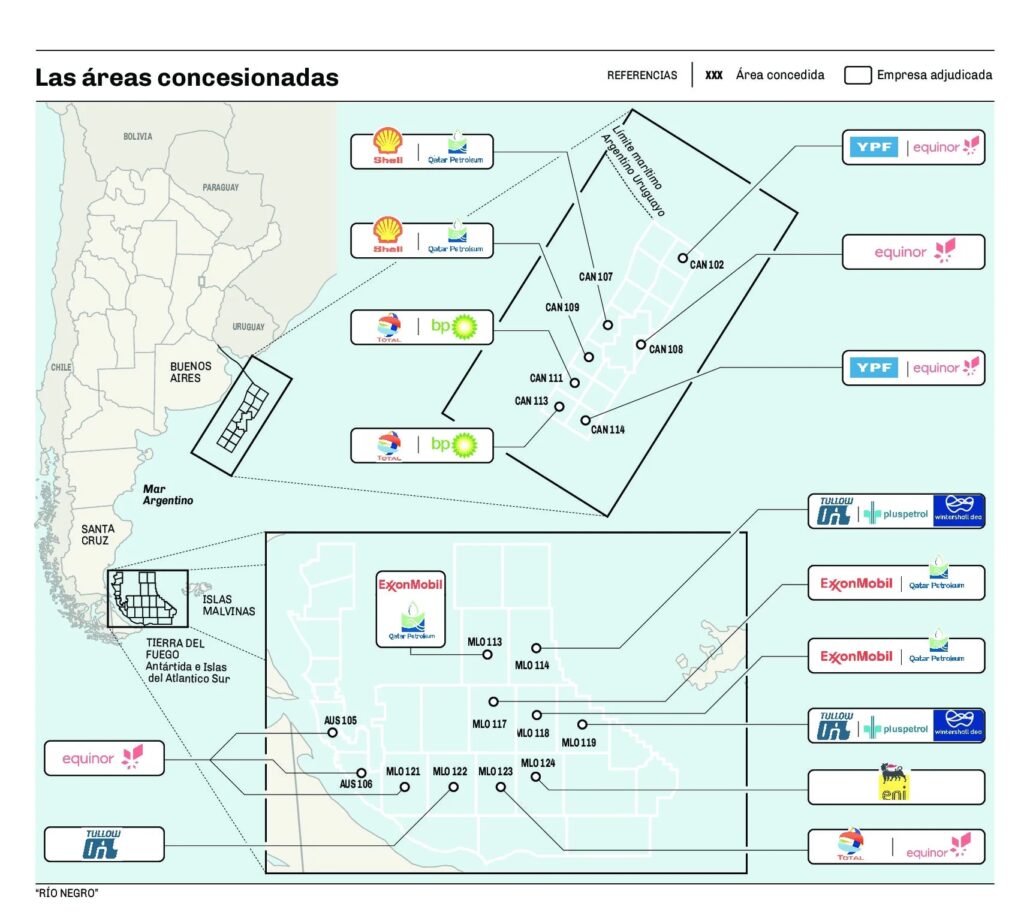
Equinor’s initial investments were in the exploration and development of unconventional wells in Vaca Muerta, specifically for the extraction of crude oil from shale formations via fracking.
Ever since fracking began in Northern Patagonia, in 2011, the territory has been suffering from a considerable transformation process.
- The lands used for cattle raising and fruit production are slowly being taken over by hydrocarbon activities. In Neuquén, Río Negro, and Mendoza, there has been an uptick in conflicts due to companies entering into peasant farmlands used for livestock farming and for a large variety of production activities related to the life of rural towns. This also affects the Mapuche People, whose territory has been leased for its exploitation without their consent. These conflicts led to an increase in the criminalization of Mapuche leaders, particularly during the 2017-2019 period, when there were attempts to characterize the Mapuche struggle as terrorism.
- There is an escalating competition for water between fracking and production activities, considering that Northern Patagonia has been consistently struggling with a drought that affects the basin of the Neuquén, Limay, and Negro Rivers — one of the country’s most prominent basins.
- As fracking developments grew, so did the number of complaints raised due to poor management of waste in treatment plants (there are ongoing legal cases).
- Seismic activity has started to appear in an unprecedented area, and the epicenter of these movements is found particularly at a very low depth.
- Although job positions were created thanks to the development of unconventional formations, as the activity is innately volatile, the number of people employed is constantly fluctuating, just like working conditions. Nine workers have died in conventional and unconventional fields in the Neuquén basin since 2017, together with the flexibilization of working conditions.
- Increase in “environmental incidents”. In 2021, the Undersecretariat of Environment of the province of Neuquén declared that there were 2,049 “environmental incidents” in hydrocarbon areas. This represents an average of 5.6 incidents a day, more than twice the number of incidents recorded in 2017, when the average was 2.8. These are the incidents declared: spills of crude oil, produced water, fluids with hydrocarbon concentrations, muds, gas oil, chemical substances, hydraulic oil, lubricants, fuels, and cooling oil; gas leaks; incipient stage fires; and blowouts (total loss of control of wells which leads to an uncontrolled release of oil and/or gas).
This line of intervention fosters fossil fuel combustion, regardless of the fact that the company is trying to make the extractive process greener by cutting down carbon emissions. In 2017, Equinor was part of a bidding process for ultra-deepwater exploration blocks in the Argentine Sea. Of the 18 blocks that were granted during that round, the company has an interest in seven. Moreover, they have been awarded an additional block via another bidding process. This makes Equinor a leading player in the expansion of the extractive frontier in Argentina’s ultra-deep waters, together with Wintershall, BP, ExxonMobil, Total, Shell, Qatar Petroleum, ENI, Tullow, YPF, Pluspetrol, Tecpetrol, and Mitsui.
This move towards fossil fuels has been met with widespread rejection and mass demonstrations defending the sea and all its life forms, known as #Atlanticazo. The epicenter of these demonstrations is the city of Mar del Plata, and the main actors are the Asambleas por un Mar Libre de Petroleras [Assemblies for and oil-free sea].
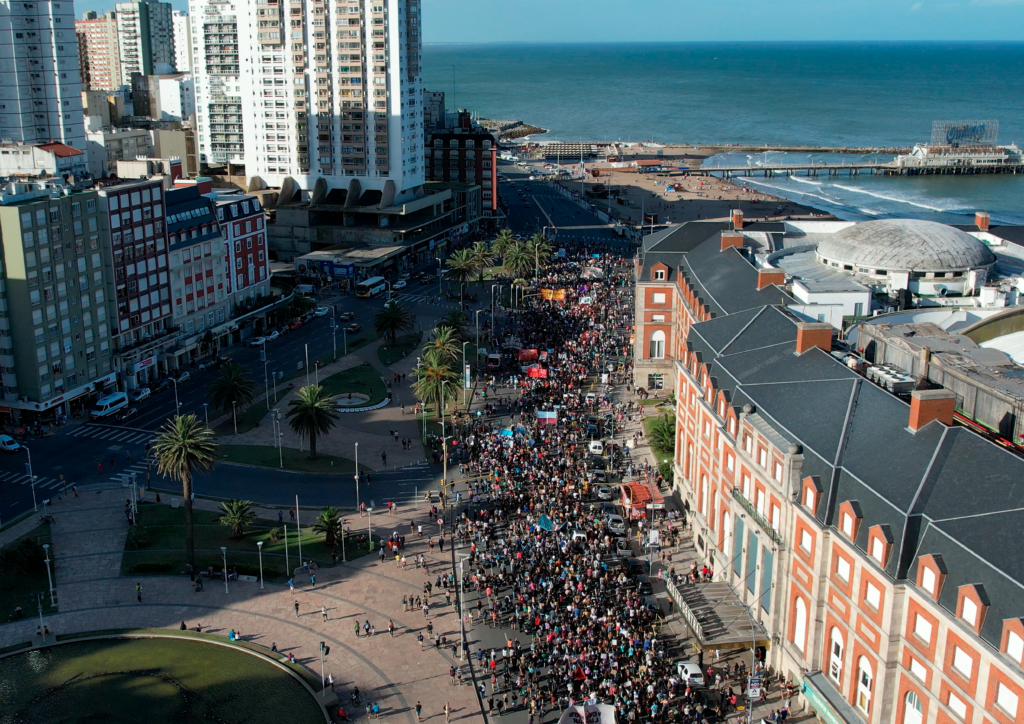
Impacts
Objections were raised during the Public Hearing carried out in July 2021, where Equinor submitted the Environmental Impact Study for the seismic exploration of the CAN 100, 108, and 114 blocks. There were concerns about the company’s responsibility regarding matters of utmost importance for the international agenda (for which the Argentine government has entered into agreements), such as the commitments towards climate change, the contribution to the use of fossil fuels in the energy mix, and the impacts on future generations. The submitted Environmental Impact Study was also heavily criticized because it lacks a holistic approach to the cumulative effects of the activity on the sea ecosystem, and its relation to the main economic activities of coastal communities, like fishing and tourism(3).
Sea Life(4)
One of the main warnings is related to the effects of low-frequency acoustic blasting on mammals and on the local fishery resources. The affected communities targeted Equinor for underestimating the impacts of the activities, considering there are threatened species involved, like the Southern right whale, and important conservation areas. They have also challenged the mitigation measures suggested by the oil company, which are allegedly based on the sea fauna’s ability to dodge, escape, or deviate their routes and natural cycles while exploration and exploitation are taking place.
Monitoring whales’ migratory routes shows the negative impact that seismic prospecting activities can have on them and their habitat. Blocks CAN 100, 108, and 114 overlap with areas that are highly important for Southern right whales throughout their feeding season, i.e., spring and summer. These blocks also overlap with habitats with great biodiversity and are the areas where relevant ecological processes take place, like the spawning of ecologically and commercially relevant species, squids’ migration, and feeding for birds, turtles, and sea mammals. Due to their ecosystem value, these same areas were identified as potential Marine Protected Areas by the National Ministry of Environment and Sustainable Development, so the decision is absolutely contradictory.
Moreover, cetaceans depend on sound production and perception for most of their vital functions, such as getting information about their surroundings, detecting preys and predators, orienting themselves, communicating, and breeding. Therefore, adding a high intensity noise, such as that created by prospections, affects their core biological functions, and also creates physiological and physical damage that can lead to their death.
Fishing and Tourism(6)
According to the National Ministry of Agriculture, Livestock and Fisheries, during 2020, 49% of the species captured nationwide arrived at the Port of Mar del Plata. The Port of Mar del Plata is the main port of the country, where most of the fishing fleet works, followed by Patagonian ports, where the freezer trawler fleet operates. According to the Economic Policy Secretariat, Mar del Plata concentrates 63% of processing plants and refrigerated warehouses; and 82 of them are authorized to export to the European Union. From that city, fresh fish products that are consumed domestically in Argentina are distributed.
The city of Mar del Plata is also one of Argentina’s top tourist locations. This industry employs 14% of workers from the General Pueyrredón town, that is, almost 50,000 workers.
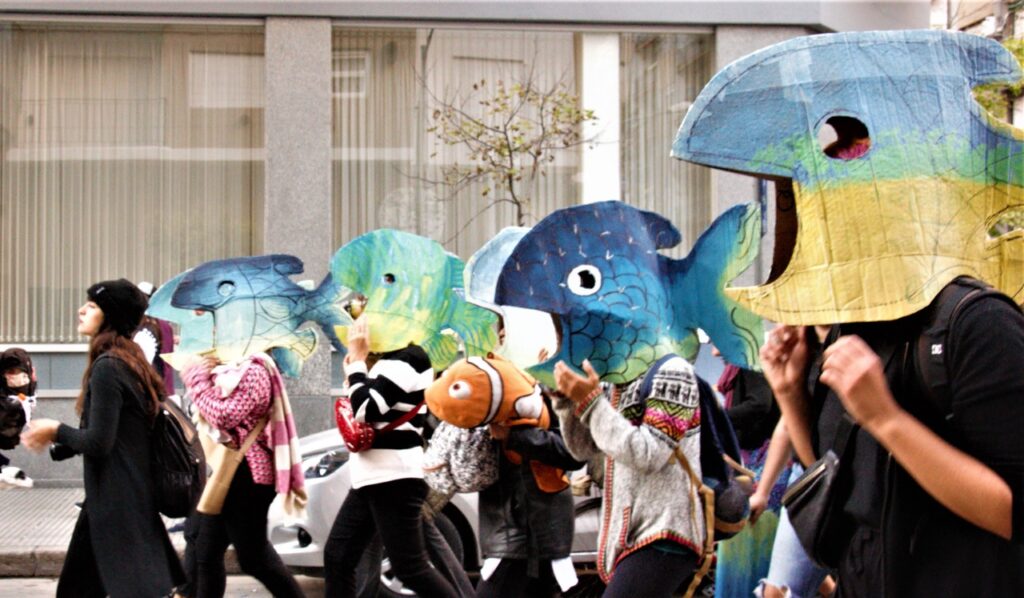
Timeline
2017.
August. Equinor entered into an agreement with State-owned oil company YPF S.A. to develop the Bajo del Toro block (with a 50%-50% interest), in the province of Neuquén. The Argentine company retained the block’s operation.
October. As an operator (90%), Equinor was awarded the Bajo del Toro Este area, linked to the Neuquén-based company GyP (10%).
2018.
June. With Scatec Solar, they control the Cordillera Solar VIII S.A. company, which owns the solar photovoltaic farm Guañizuil 2A, with 117 MW of installed capacity, located in the province of San Juan.
2019.
April. Equinor is granted exploration rights for seven offshore blocks, scattered along the Argentina Norte (CAN), Austral (AUS), and Malvinas Oeste (MLO) basins. It is the operator of five blocks and a partner in two. Operator: CAN 108 (100%); CAN 114 (50%), in partnership with YPF (50%); MLO 121 (100%); AUS 105 (100%); and AUS 106 (100%). Partner: CAN 102 with YPF, 50% each; and MLO 123, operation is run by Total (37.5%), YPF (30%), and Equinor (37.5%).
August. Equinor was given access to the CAN 100 block as a partner of YPF (35%) and Shell (30%); Equinor became the operator (35%).
It entered into an agreement with YPF Luz via its Wind Power subsidiary, which gave Equinor 50% of the Cañadón León wind farm project, in the province of Santa Cruz.
December. Equinor was given access to the Águila Mora Noreste block (90%) in partnership with the provincial GyP company (10%).
2020.
January. Equinor entered Bandurria Sur, an area of oil exploitation through fracking, in partnership with Shell, as Bandurria Sur Investments; they have a 60% interest (30% each); YPF owns the remaining 40% and is the operator.
May. Equinor terminated the agreement entered into with YPF Luz in the context of a 3 billion USD action plan to downsize its investments, costs, and exploration, and to cope with market fluctuations.
2021.
February. Bandurria Sur had one of the best production results in Vaca Muerta: it reached 13,000 bpd of shale oil.
July. In an online public hearing, Equinor introduced its 2D and 3D seismic exploration plan for the ultra-deepwater blocks CAN 100, 108, and 114, located off the coast of the province of Buenos Aires. Many people living in coastal cities attended the hearing. An overwhelming majority was opposed to the initiative and, as a result, the authorization process deadline was postponed until Equinor provided further information.
November. Equinor returned to the province of Neuquén the lease of the Bajo del Toro Este and Águila Mora Noreste areas, of which it was the operator, in partnership with GyP.
December. On the last business day of the year, the national authorities published the authorizations for Equinor to start seismic exploration activities in the CAN 100, CAN 114, and CAN 108 blocks, in the Argentine Sea.
2022
January. Demonstrations against the authorizations that Equinor was granted increase in coastal cities, like tourist hub Mar del Plata; the #Atlanticazo takes place. Moreover, legal injunctions are granted to preventively halt the authorization given to the company and to the other partnered companies, YPF and Shell.
April. Equinor managed to get, together with Shell and YPF, extensions on the deadlines for the exploration permits of blocks CAN 114 (two years), CAN 100 (two years), CAN 102 (one year), AUS 105 and AUS 106 (two years).
May. New online public hearings were organized, both locally and nationally, where new background information was given regarding the exploration activities in blocks CAN 100 (which includes drilling the exploration well Argerich – 1), and CAN 102. Equinor has an interest and is publicly recognized in both blocks. Once again, many people attended the hearings and rejected the company’s activities in partnership with YPF.
August. The National Ministry of Environment ratified Equinor’s authorization to carry out exploratory activities in blocks CAN 100, 108, and 114. For CAN 100 and 108 areas, located more than 300 km off the coast of Mar del Plata, these activities will be executed over 6,245 square kilometers. In the CAN 114 area, in turn, the surface to be explored is about 3,443 square kilometers, and it is located some 400 km off the coast of Necochea, another tourist city.
The seismic survey is planned for a five-month period, during the year’s second semester. So, if all goes according to plan, it will begin in October 2022, and it should be completed by March 2023. Survey data processing will take over a year.
Notes:
(1) “YPF y Equinor se reunieron con el presidente de la Nación” [YPF and Equinor met with the Argentine President], YPF, December 3rd, 2021.
(2) “Where we are” in Equinor, undated.
(3) “Informe Final de la Audiencia Pública N°1/21” [Final Report of Public Hearing No. 1/21]; Ministry of Environment and Sustainable Development; July 1st, 2nd, and 5th, 2021; EX-2021-47732609- -APN-DGAYF#MAD
(4) Florencia Sciutti, F. and Escobar, R. “Diego Taboada: ‘Las prospecciones sísmicas se superponen con un área muy relevante para las ballenas francas’” [Diego Taboada: “Seismic prospecting activities overlap with a highly relevant area for Southern right whales”], in La Izquierda Diario, January 5th, 2022.
(5) María Marta Di Paola and Federico Sibaja, “La economía del offshore, ¿un buen negocio?” [The offshore economy, a good business?], in Greenpeace Argentina, January 21st, 2022.
More info:
Oil Companies at Sea: Energy Transition as Extractivism’s Flagship Program
Norway at the Forefront: Extreme Energy Projects in the Argentine Sea
European companies set to conquer Vaca Muerta
Translated by Territorio de Ideas.
